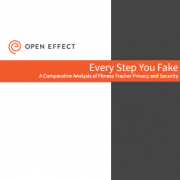
I had the pleasure of attending the 2015 Privacy Enhancing Technologies Symposium (PETS) at Drexel University in Philadelphia, where I did two presentations. PETS is an academic research conference showcasing the latest technical innovations designed to help safeguard personal information.
My first talk, at the Workshop on Surveillance and Technology, presented research into the adoption of the HTTPS data transmission protocol by various categories of websites. HTTPS encrypts regular Internet traffic, which makes it difficult for a third party to know what you’re communicating, and ensures the data you receive hasn’t been tampered with en route to your computer. The work-in-progress paper details a methodology for determining whether or not a given website will allow a user to browse securely. This is different than simply measuring whether or not a website can successfully communicate using HTTPS, because many websites don’t secure their main properties with the technology, and force users to browse insecurely instead. See some of my earlier writings for more detail about this.
On the conference’s last day, I presented at HotPETS, where the latest cutting-edge privacy research is presented for debate and discussion. I discussed the Access My Info (AMI) tool, which helps people create legal requests for access to their personal information. I discussed the tool’s origin in Dr. Christopher Parsons’ Telecommunications Transparency Project, the design rationale for the tool, and the impact it had when we released it to the Canadian public. The development of AMI is currently funded by the Canadian Internet Registration Authority.
Overall, the conference was filled with exciting discussions about the future of privacy. Personally, I received some very helpful feedback on both of my presentations which I put into effect immediately.

 Request access to your personal data with our simple tool
Request access to your personal data with our simple tool


